Among the classic Japanese motorcycles that deserve a modern tribute, few come to mind as quickly as Honda’s line of air-cooled, in-line fours, starting with the CB750K0 of 1969. Its 40-year anniversary was suitably commemorated with the unveiling of the CB1100 at the Tokyo Motor Show in 2009, but production models only came to Japan and Australia in 2010. American Honda gave us a sneak peek at a sample it had in-house that year and asked for input on its sales potential, but chose not to introduce it here until this year, when several high-value models were added to its lineup. Along with the new NC700X and, quite probably, its trio of CB500s (we’ll know soon), the CB1100 packs a lot of practical motorcycling in an attractive, timeless design—in other words, a lot of value.
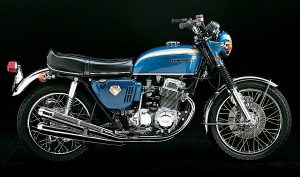
The first-ever mass-produced in-line four that started the Superbike era. Dick Mann piloted a race-kitted CB750 to win the 1970 Daytona 200, earning Honda its first win in AMA competition. Honda made huge investments in R&D with the profits from the CB750, which helped fuel the growth of the company in the 1970s.
While the original Fours were considered jewel-like at the time, and the 1969 CB750 in particular posted the fastest lap times, shortest stopping distances and competitive quarter-mile times back in its day, time has marched on. I wanted to see how much by riding one back-to-back with the CB1100, and in a happy coincidence my friend Marty Estes needed to tune-up his 1974 CB750K4. You use my lift; I get to ride it—done deal. Although it hadn’t been fired in many years, Marty had recently rebuilt the front end with tapered-roller steering head bearings and new fork seals. Before he brought it over, the bike also got a new battery, clutch, tires and an O-ring chain, a carburetor and brake rebuild and an oil-change. Once we had adjusted the valves and cam chain, filed the points and set the static timing, the lovely blue-and-black bike fired up readily, but cylinders 2 and 3 clearly weren’t happy. Diagnosis: piston rings stuck in the lands, preventing full compression. Marty had properly stored the bike with oil in the cylinders, but we laughed as he recalled that it had actually been, uh, 10 years, not four, since it was last started. Time flies….
Anyway, after squirting some Marvel Mystery Oil in the cylinders and letting it sit over the weekend, we fired it, the rings unstuck and the problem was solved. We synched the carbs, then it was time for a ride!
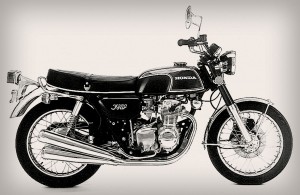
The 350cc version of the 4-cylinder Honda SOHC engine design had a reputation for smooth running when the standard engine configuration of the time in this displacement class was a lumpy parallel twin.
Forgetting about the obvious power disparity, it is remarkable how Honda was able to make the character of the new engine reminiscent of the old. The ringing from the older bike’s cam chain keeps it from sounding the same mechanically as the nearly silent newer one, but the CB1100’s staggered intake-valve timing roughs-up its power delivery enough to give it the same sort of lumpiness. Both are five speeds, of course, and both build revs smoothly and gradually. Where the CB1100 uses a pair of rubber engine mounts and a balancer shaft to quell vibration, however, the older bike makes little pretense at controlling it and buzzes a lot by comparison.
You can see in the photo how similar the seating positions are, which they got right back then, as well as now. Marty has Progressive Suspension shocks on the back of his bike so it’s hard to say how the originals would have compared. Probably much like the fork, which is not well. The CB750’s skinny frame tubes look as though they could fit inside the CB1100’s thick ones, but detecting any weakness would have required pushing the 750 harder than Marty would have liked. If there’s one thing for which we can definitely thank progress it’s the brakes. Despite having the first front disc and a recent rebuild, like most early motorcycles, the CB750 required using both brakes to stop adequately, with a firm four-finger squeeze at the lever.
It’s fun to remember these old bikes as the harbingers of a wonderful era of motorcycling. Enjoying them as collectibles and on short rides can be done on the cheap, too, if you have some mechanical skills…and don’t mind the faint smell of gasoline in your garage.
* This article was published as a sidebar to a review of the 2013 Honda CB1100. To read that review, CLICK HERE.
(This article Back to Back Classics was published in the July 2013 issue of Rider magazine.)

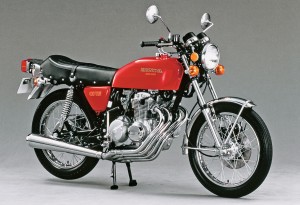
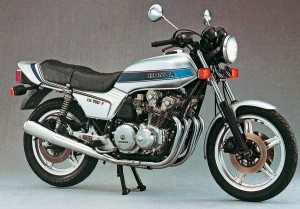
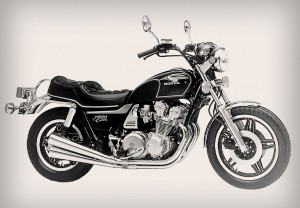
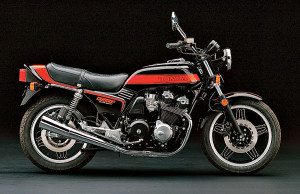
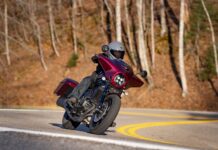





Boy did this Articular bring back Memories !!
I bought a Blue
1980 Honda CB 900 Custom (New) in Early 1980 from Kobe Cycle Sales in Woodland Hills, California.(Now out of Business) and around a year later put a Color Matched “Vetter” Farring and Bags with top Box and took a long Tour to New Mexico to attend the Aspencade Rally in 1981
And won a T ropy for the “Longest Distance Rider” !!